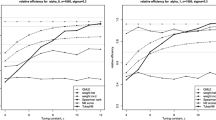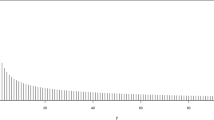Abstract
There has been a considerable and growing interest in low integer-valued time series data leading to a diversification of modelling approaches. In addition to static regression models, both observation-driven and parameter-driven models are considered here. We compare and contrast a variety of time series models for counts using two very different data sets as a testbed. A range of diagnostic devices is employed to help inform model adequacy. Special attention is paid to dynamic structure and underlying distributional assumptions including associated dispersion properties. Competing models show attractive features, but overall no one modelling approach is seen to dominate.
Similar content being viewed by others
References
Bollerslev, T.: Generalized autoregressive conditional heteroscedasticity. J. Econom. 31, 307–327 (1986)
Brännäs, K.: Estimation and testing in integer-valued AR(1) models. University of Umeå Discussion Paper No. 335 (1994)
Brännäs, K., Johansson, P.: Time series count data regression. Commun. Stat., Theory Methods 23, 2907–2925 (1994)
Bu, R., McCabe, B.P.M.: Model selection, estimation and forecasting in INAR(p) models: A likelihood-based Markov chain approach. Int. J. Forecast. 24, 151–162 (2008)
Bu, R., McCabe, B.P.M., Hadri, K.: Maximum likelihood estimation of higher-order integer-valued autoregressive processes. J. Time Ser. Anal. 29, 973–994 (2008)
Cameron, A.C., Trivedi, P.K.: Regression Analysis of Count Data. Cambridge University Press, Cambridge (1998)
Chan, K., Ledolter, J.: Monte Carlo EM estimation for time series models involving counts. J. Am. Stat. Assoc. 90, 242–252 (1995)
Consul, P.C.: Generalized Poisson Distributions: Properties and Applications. Dekker, New York (1989)
Cox, D.R.: Statistical analysis of time series: Some recent developments. Scand. J. Stat. 8, 93–115 (1981)
Czado, C., Gneiting, T., Held, L.: Predictive model assessment for count data. Biometrics 65, 1254–1261 (2009)
Davidson, R., MacKinnon, J.G.: Estimation and Inference in Econometrics. Oxford University Press, New York (1993)
Davis, R.A., Wu, R.: A negative binomial model for time series of counts. Biometrika 96, 735–749 (2009)
Davis, R.A., Dunsmuir, W.T.M., Wang, Y.: Modeling time series of count data. In: Ghosh, S. (ed.) Asymptotics, Nonparametrics, and Time Series: A Tribute to Madan Lal Puri, pp. 63–116. Dekker, New York (1999)
Davis, R.A., Dunsmuir, W.T.M., Wang, Y.: On autocorrelation in a Poisson regression model. Biometrika 87, 491–505 (2000)
Davis, R.A., Dunsmuir, W.T.M., Streett, S.B.: Observation-driven models for Poisson counts. Biometrika 90, 777–790 (2003)
Davis, R.A., Dunsmuir, W.T.M., Streett, S.B.: Maximum likelihood estimation for an observation driven model for Poisson counts. Methodol. Comput. Appl. Probab. 7, 149–159 (2005)
Dawid, A.P.: Statistical theory: The prequential approach. J. R. Stat. Soc. Ser. A 147, 278–292 (1984)
Du, J.G., Li, Y.: The integer-valued autoregressive (INAR (p)) model. J. Time Ser. Anal. 12, 129–142 (1991)
Durbin, J., Koopman, S.J.: Time series analysis of non-Gaussian observations based on state space models from both classical and Bayesian perspectives. J. R. Stat. Soc. B 62, 3–56 (2000)
Efron, B.: Double exponential families and their use in generalized linear regression. J. Am. Stat. Assoc. 81, 709–721 (1986)
Engle, R.F., Russell, J.R.: Autoregressive conditional duration: A new model for irregularly spaced transaction data. Econometrica 66, 1127–1162 (1998)
Fahrmeir, L., Tutz, G.: Multivariate Statistical Modelling Based on Generalized Linear Models, 2nd edn. Springer, New York (2001)
Farrell, P.J., MacGibbon, B., Tomberlin, T.J.: A hierarchical Bayes approach to estimation and prediction to time series of counts. Braz. J. Probab. Stat. 21, 187–202 (2007)
Feigin, P.D., Gould, P., Martin, G.M., Snyder, R.D.: Feasible parameter regions for alternative discrete state space models. Stat. Probab. Lett. 78, 2963–2970 (2008)
Ferland, R., Latour, A., Oraichi, D.: Integer-valued GARCH process. J. Time Ser. Anal. 27, 923–942 (2006)
Fokianos, K.: Truncated Poisson regression for time series of counts. Scand. J. Stat. 28, 645–659 (2001)
Fokianos, K., Rahbek, A., Tjøstheim, D.: Poisson autoregression. J. Am. Stat. Assoc. 104, 1430–1439 (2009)
Freeland, R.K., McCabe, B.P.M.: Analysis of count data by means of the Poisson autoregressive model. J. Time Ser. Anal. 25, 701–722 (2004)
Frey, S., Sandås, P.: The impact of iceberg orders in limit order books (2009). http://ssrncom/abstract=1108485
Gneiting, T., Raftery, A.E.: Strictly proper scoring rules, prediction, and estimation. J. Am. Stat. Assoc. 102, 359–378 (2007)
Gneiting, T., Balabdaoui, F., Raftery, A.E.: Probabilistic forecasts, calibration and sharpness. J. R. Stat. Soc. Ser. B 69, 243–268 (2007)
Gouriéroux, C., Holly, A., Monfort, A.: Likelihood ratio test, Wald test, and Kuhn–Tucker test in linear models with inequality constraints on the regression parameters. Econometrica 50, 63–80 (1982)
Grunwald, G.K., Hyndman, R.J., Tedesco, L., Tweedie, R.L.: Non-Gaussian conditional linear AR(1) models. Aust. N. Z. J. Stat. 42, 479–495 (2000)
Harvey, A.C.: Forecasting, Structural Time Series Models and the Kalman Filter. Cambridge University Press, Cambridge (1989)
Harvey, A.C., Fernandes, C.: Time series models for count or qualitative observations. J. Bus. Econ. Stat. 7, 407–417 (1989)
Heinen, A.: Modelling time series count data: The autoregressive conditional Poisson model. CORE Discussion Paper No. 2003-63 (2003)
Joe, H.: Time series models with univariate margins in the convolution-closed infinitely divisible class. J. Appl. Probab. 33, 664–677 (1996)
Jung, R.C., Liesenfeld, R.: Estimating time series models of count data using efficient importance sampling. Allg. Stat. Arch. 85, 387–407 (2001)
Jung, R.C., Tremayne, A.R.: Binomial thinning models for integer time series. Stat. Model. 6, 81–96 (2006a)
Jung, R.C., Tremayne, A.R.: Coherent forecasting in integer time series models. Int. J. Forecast. 22, 223–238 (2006b)
Jung, R.C., Tremayne, A.R.: Convolution-closed models for count time series with applications. J. Time Ser. Anal. (Forthcoming)
Jung, R.C., Ronning, G., Tremayne, A.R.: Estimation in conditional first order autoregression with discrete support. Stat. Pap. 46, 195–224 (2005)
Jung, R.C., Kukuk, M., Liesenfeld, R.: Time series of count data: Modeling, estimation and diagnostics. Comput. Stat. Data Anal. 51, 2350–2364 (2006)
Jung, R.C., Liesenfeld, R., Richard, J.F.: Dynamic factor models for multivariate count data: An application to stock-market trading activity. J. Bus. Econ. Stat. doi:10.1198/jbes.2009.08212
Kedem, B., Fokianos, K.: Regression Models for Time Series Analysis. Wiley, Hoboken (2002)
Kuk, AY, Cheng, Y.W.: The Monte Carlo Newton–Raphson algorithm. J. Stat. Comput. Simul. 59, 233–250 (1997)
MacDonald, I.L., Zucchini, W.: Hidden Markov and Other Models for Discrete-valued Time Series. Chapman and Hall, London (1997)
McCabe, B.P.M., Martin, G.M., Harris, D.: Optimal probabilistic forecasts for counts. Working Paper (2009)
McKenzie, E.: Discrete variate time series. In: Shanbhag, D., Rao, C. (eds.) Handbook of Statistics, vol. 21, pp. 573–606. Elsevier Science, Amsterdam (2003)
Monteiro, A.A.: Parameter driven multi-state duration models: simulated vs. approximated maximum likelihood estimation. Tinbergen Institute Discussion Paper 2008-021/2 (2008)
Oh, M.S., Lim, Y.B.: Bayesian analysis of time series Poisson data. J. Appl. Stat. 28, 259–271 (2001)
Rosenblatt, M.: Remarks on a multivariate transformation. Ann. Math. Stat. 23, 470–472 (1952)
Shephard, N.G.: Generalized linear autoregressions. Working Paper, Nuffield College, Oxford (1995)
Weiß, C.H.: Thinning operations for modelling time series of counts—a survey. Adv. Stat. Anal. 92, 319–341 (2008)
Weiß, C.H.: Modelling time series of counts with overdispersion. Stat. Methods Appl. 18, 507–519 (2009)
Wooldridge, J.M.: Quasi-likelihood methods for count data. In: Pesaran, H., Schmidt, P. (eds.) Handbook of Applied Econometrics, pp. 352–406. Blackwell, Oxford (1999)
Zeger, S.L.: A regression model for time series of counts. Biometrika 75, 621–629 (1988)
Zeger, S.L., Qaqish, B.: Markov regression models for time series: A quasi-likelihood approach. Biometrics 44, 1019–1031 (1988)
Author information
Authors and Affiliations
Corresponding author
Additional information
The original seeds of this paper can be found in an invited lecture given by the first author at the Pfingsttagung of the DStatG in Hamburg 2006. We are grateful to the DFG for financial support under the grant JU 2776/2-1.
Rights and permissions
About this article
Cite this article
Jung, R.C., Tremayne, A.R. Useful models for time series of counts or simply wrong ones?. AStA Adv Stat Anal 95, 59–91 (2011). https://doi.org/10.1007/s10182-010-0139-9
Received:
Accepted:
Published:
Issue Date:
DOI: https://doi.org/10.1007/s10182-010-0139-9




